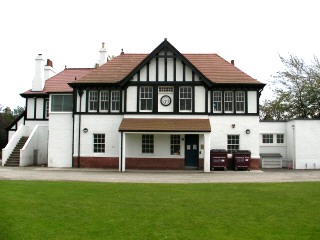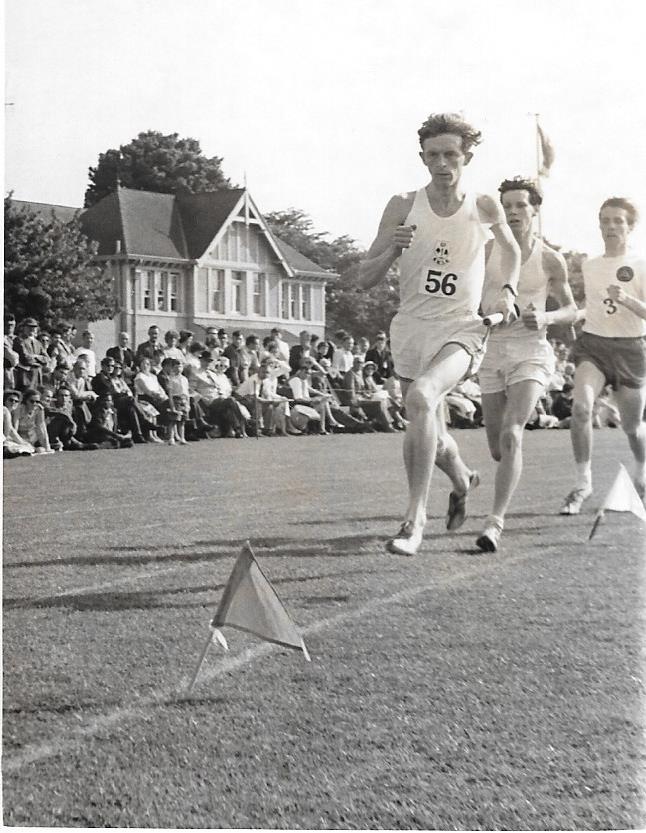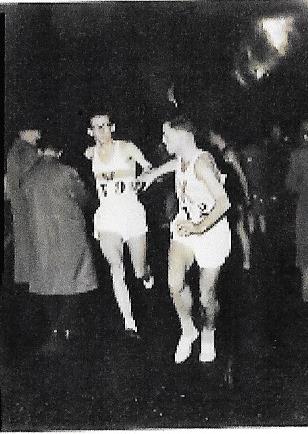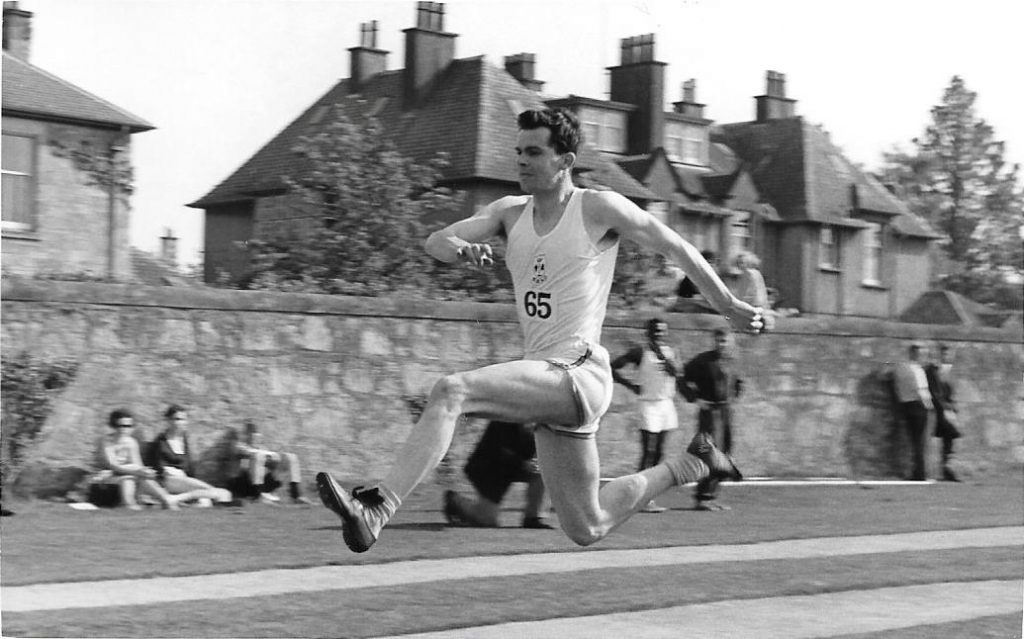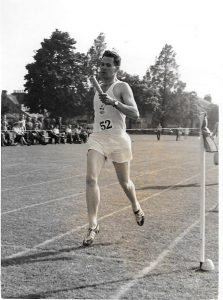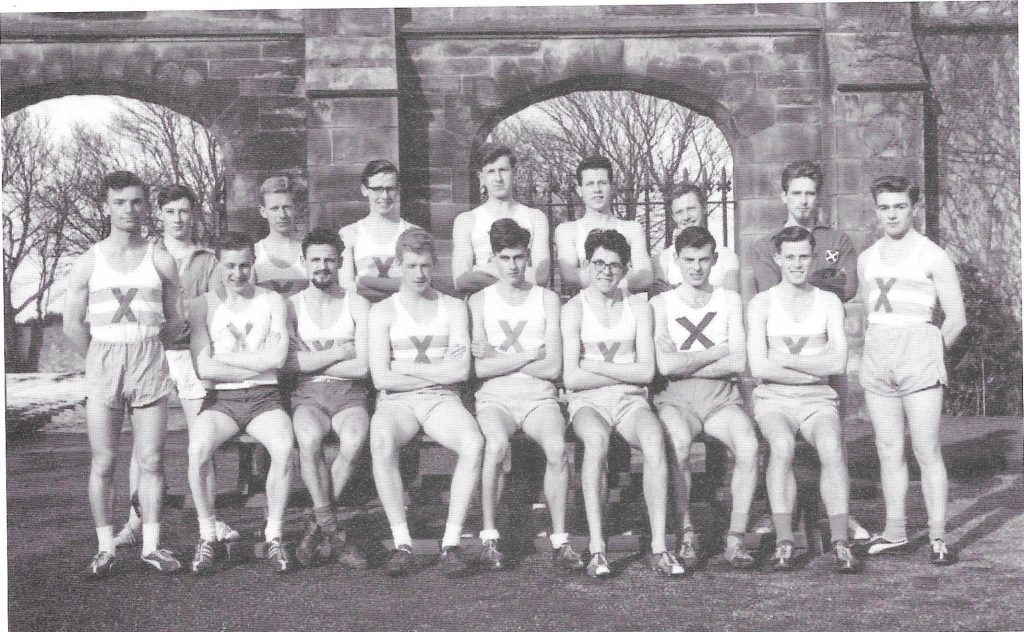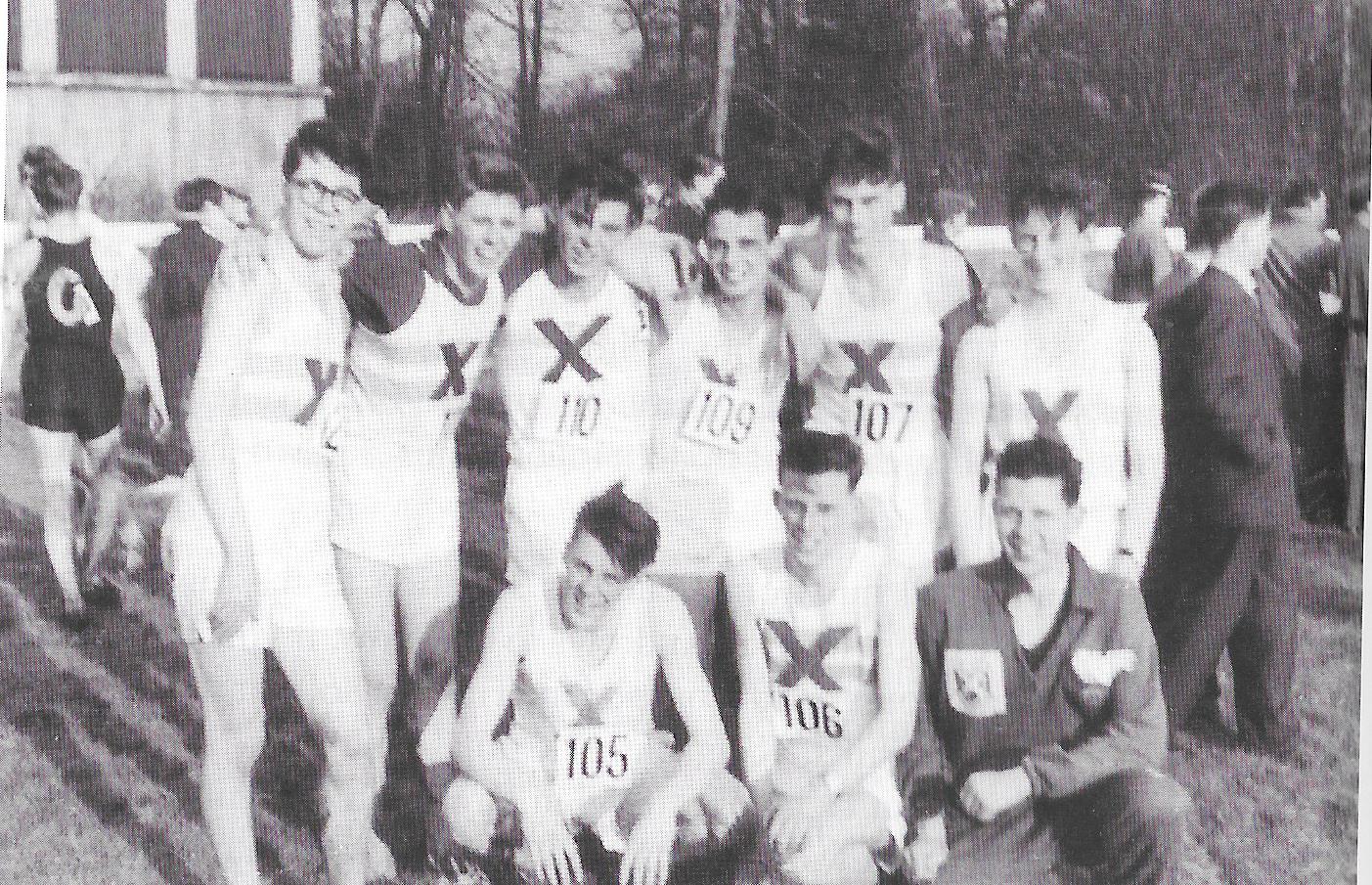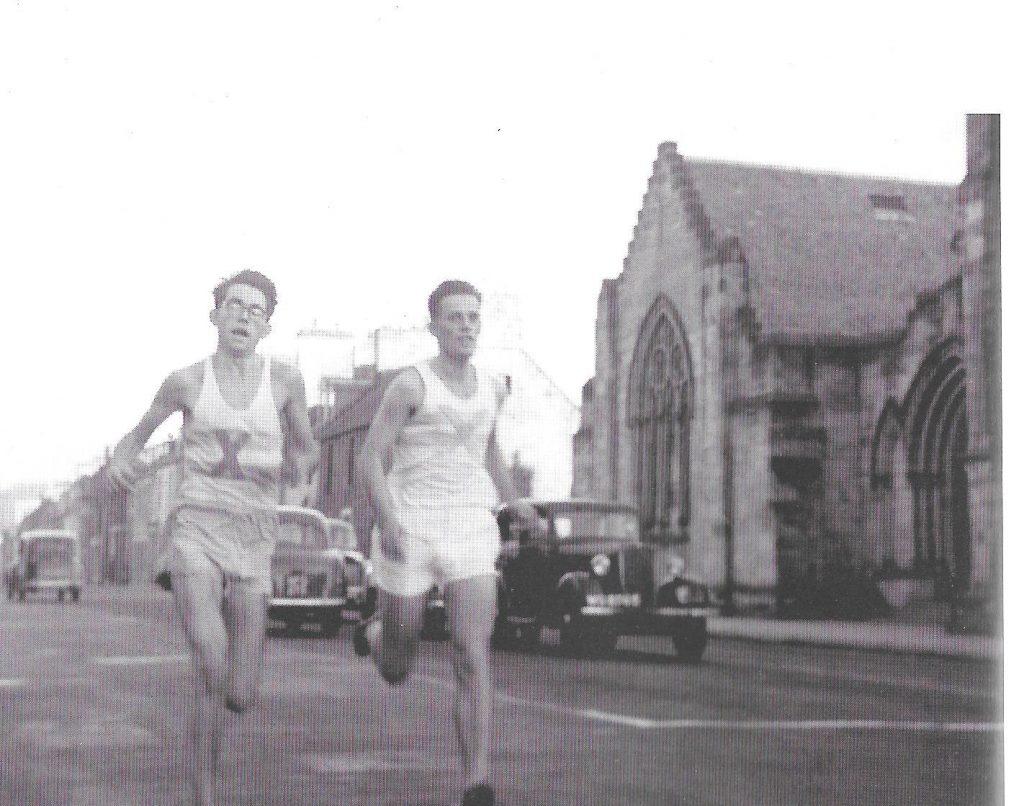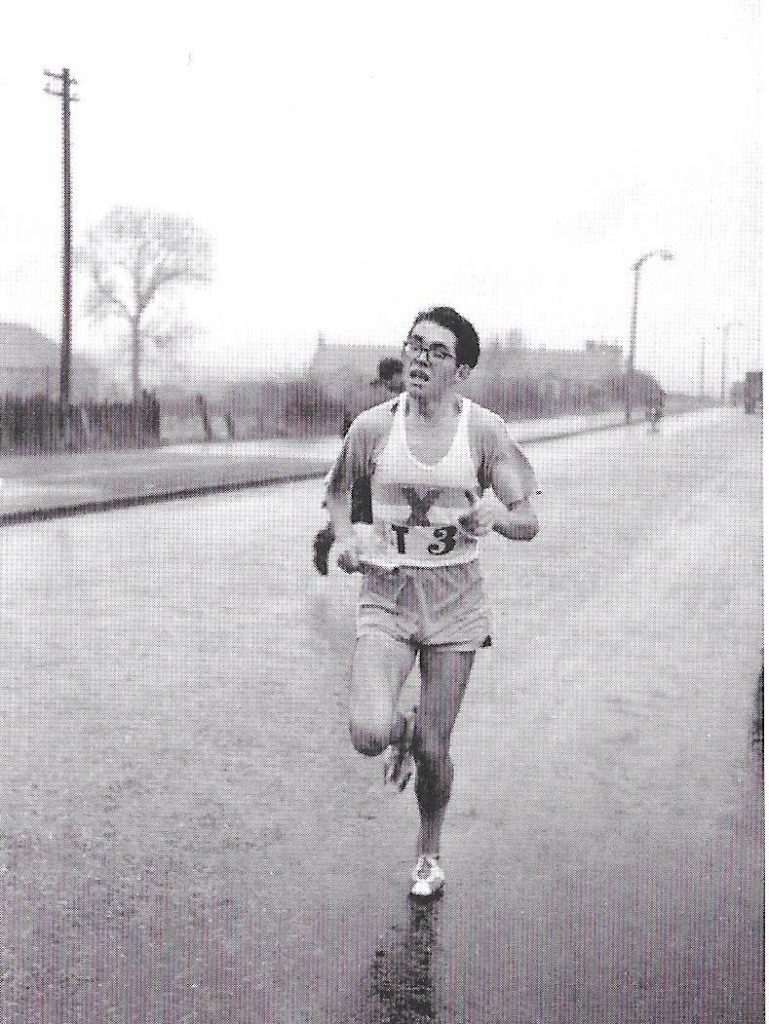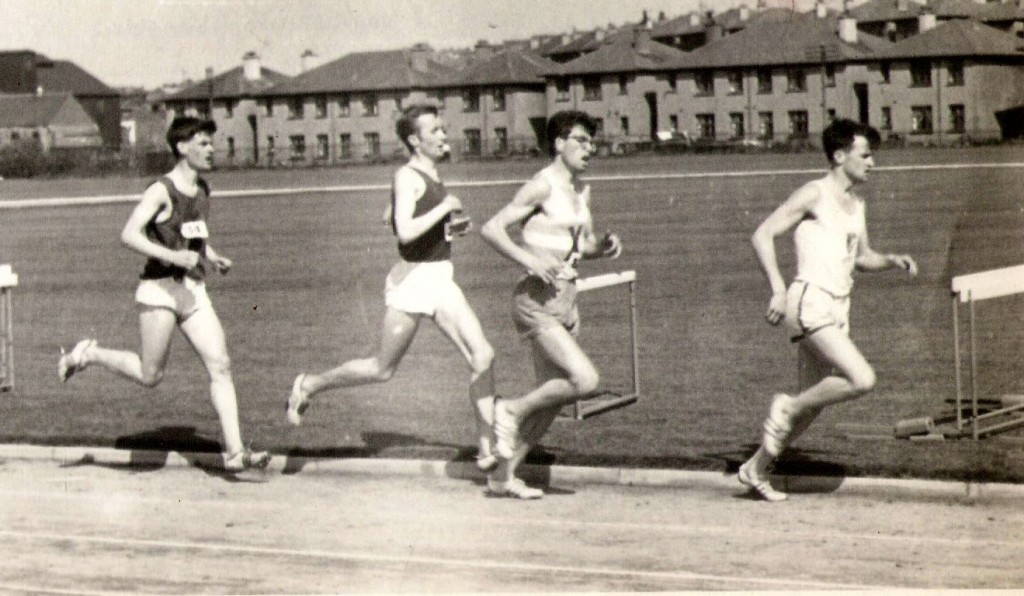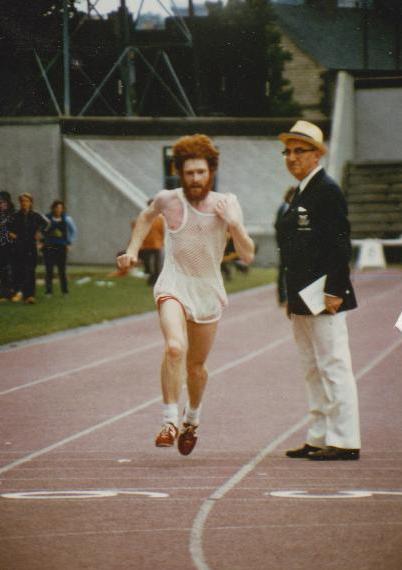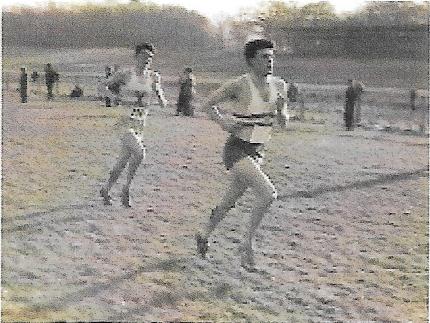Sports Pavilion
St Andrews University has been involved in Scottish university athletics since before 1871 when the first inter-university sports were held. Like the other university grounds – Craiglockhart, King’s College and Westerlands – it has its own facilities for sport and a distinct history. The former is shaped by and to an extent helps shape the latter. The facilities will be looked at as they affect athletics, and the performances by students and teams down the years will be looked at up to the start of the ‘modern’ era of all-weather tracks and the growth of the university athletic scene from four universities to a multitude.
The St Andrews University website says at the start of the sports pages:
Sport has played an important part of life in St Andrews ever since the founding of the University in 1413. The earliest record of student sport in St Andrews dates back to 1618 with the Archery Club. The next clubs to be founded were the University of St Andrews Golf Club in 1855 and the Rugby Football Club in 1858, but it wasn’t until 1901 that student sport was fully represented when the Athletic Union was instituted by Professor Scott Lang. A year later, University Rector Andrew Carnegie gifted the first sports facilities to the university and subsequently became Honorary President of the Athletic Union. The Department of Physical Education was introduced by the university in 1955, with the first Sports Centre built in 1968. 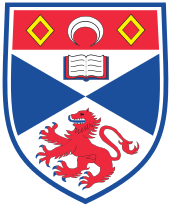
The first Scottish Inter-University championships were held on 23rd March in 1873 at Raeburn Place in Edinburgh and the universities of Edinburgh, Glasgow and St Andrews took part, Aberdeen was absent ‘due to a misunderstanding.; Edinburgh won the competition quite comfortably but there were some good performances from athletes from St Andrews. eg Bairnsfather won the hurdles race, they had three excellent sprinters, and their two distance runners ‘would have given a much better account of themselves had they run in spiked shoes and got such a training as the Edinburgh men received’
The.following year the sports were held in Glasgow at Burnbank Cricket Grounds and again Edinburgh University won the contest. Star man for St Andrews was Lundie who won both heavy throwing events, but it was the third meeting that was held at St Andrews. ‘The sports took place in a field close to the town, and being of a sandy soil. was well adapted for the purpose.‘ That is the only description of the ground that we have. The meeting was interesting in that Edinburgh won from St Andrews who had two firsts and two seconds, and Glasgow who had two firsts and two seconds as well. Aberdeen turned up but only had one athlete. The university moved around different venues for their competition – eg in March 1875 they held their own sports “in a park adjacent to the Railway Station. The ground was in every way suitable for the purpose being flat and with short herbage.””
There were no more inter-university sports until 1899 when they were held at Edinburgh. So the university students interested in athletics had a team as early on as the start of the 1870’s and were able to turn out competitors in the technical field events. It is not possible to tell anything about the nature of their facilities from the above comments however.
The St Andrews website quoted above tells us that Andrew Carnegie gifted the first sports facilities to the Athletic Union in 1902. He had set up the Carnegie Trust for the Universities of Scotland with a fund of $10, 000, 000 (ie $10 million) in 1901 and was installed as Rector on 22nd October, 1902. The university sports pages on the website says that the estate stretches to 40 acres and was gifted to the University by Carnegie. If that is correct, then it was land which could be used for rugby, cricket, tennis or whatever sport needed it. He also gave money for a gymnasium.
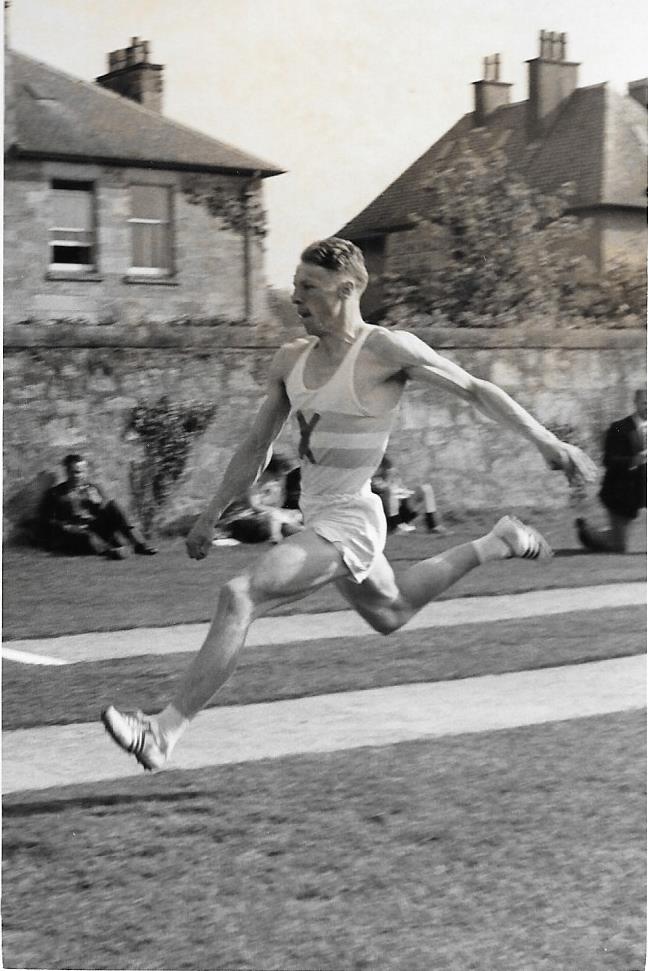 DJ Whyte competing at University Park
DJ Whyte competing at University Park
After the restart of the inter-universities championship in 1899, St Andrews did not take part until 1906 when they again joined in with the other three establishments and the rota became a four yearly one. The first inter-universities championship to be hosted by them was in 1908. That year, Glasgow and Edinburgh Universities held their championships on 13th June to help select their teams for the contest on 20th June. The “Glasgow Herald reported that the fixture was favoured with splendid weather and held, under SAAA rules, at University Recreation Park, St Andrews. Edinburgh won with 38 points from Aberdeen (18), St Andrews (10) and Glasgow (4). The report in the Glasgow Herald on the Monday after the sports read as follows (note the reference to the Lord Rector):
The Inter-Varsity ended in a very pronounced win for Edinburgh University whose representatives scored 40 points against 14 1/2 by Aberdeen, 13 for Glasgow and 2 1/2 for St Andrews. This is the first time the students of the “Grey City” have taken part in the contest, and if they did not cover themselves with glory they will no doubt do much better in the future. Thanks to the generosity of their Lord Rector they have a recreation ground which is second to none in Scotland alike in regard to situation and general appointments, and it will be nothing short of a reproach to Fifeshire students if they do not make the most of it. JP Stark, the SAAA Sprint Champion, was not among the competitors, but for all that the 100 yards fell to Glasgow, GH Walker winning after an exciting finish with JD Dickson who, the previous week, won the sprint at the West of Scotland Sports. WH Welsh who seems to have got back some of his old form won the 220 and 440 yards while he was second in the weight, which was the only other first scored by Glasgow, A McDonald putting 39 feet 5 in. AM Mathew annexed the half mile and the mile for Edinburgh, and AH Cookson of the same ‘Varsity covered 19 feet 3 in in the broad jump, while the modest performance of 5 feet 6 in won the high jump for Edinburgh.”
8th June, 1912 was the second time that the event was sponsored by the St Andrews students at University Park, and it was won by Aberdeen (34 points) from Glasgow (23), Edinburgh (17 1/2) and St Andrews (2 1/2). It was the first time that Aberdeen had won the contest. Their principal points scorer was JT Soutter who won both half-mile and mile. The track was, like almost every track in the country at the time, a good grass track and, as the illustrations on this page (from photographs taken by RR Mills of Glasgow University) show, they were still running on grass in the 1960s.
Inter Universities Three Miles at St Andrews: look at the crowd!
If we go back to the start of the century, in the second annual report of the Athletic Union it was stated that the Lord Rector “would present to the students of St Andrews a recreation ground, properly laid out and enclosed, a pavilion with dressing rooms, baths and a caretakers house and also a complete modern gymnasium.” Unfortunately there seems to be no detail or even photograph of this recreation ground with pavilion available.
After the 1914/18 war University athletics were dominated by Eric Liddell and when St Andrews again hosted the inter-universities in 1921 he had the 100 yards/220 yards double. At St Andrews, however, the 20’s and 30’s were not the best decades for athletes: if we look only at the inter-university championships held at home, performances were as follows: 1921, team position fourth, points 1 1/2; 1925, position fourth, points nil; 1929, fourth, nil; 1933, fourth, 7 points; 1937, fourth, men 6 1/2 pts, women 3 1/2 pts. Nor were there any outstanding individuals.
After the 1939/45 war it was a different story entirely. AD McDonald, writing in the ‘Scots Athlete’ magazine in July, 1947, immediately after the first post-war SAAA championships spoke of a promising newcomer that he had ‘starred’ on his programme: “To the East I turn for AS Lindsay, St Andrews University. According to the records he has shown a bare two feet less two inches improvement on his last year’s hop, step and jump; but that is beside the point: what could he do with proper care and attention? For here is a boy who exemplifies the poetry of motion, and where an athlete is basically a sound mover his possibilities are boundless. But do we ever see him in the West? Maybe the East are luckier in this respect but, sports promoters everywhere here is someone who will thrill and delight the fans. Bill him at your meets. Bring him competition from wherever it can be procured! And, Olympic Coaching panels, be on the spot to guide this boy to the top.Take care of him, Mr Quskley. (Director of Physical Training, St Andrews University. – Ed) ”
Interestingly enough, at the inter-university sports at Westerlands that year – the first after the War, Lindsay had only been second in the triple jump but he was being noticed. However, a year later and in the July issue of the same magazine in 1948 it was noted that the fine Hop, Step and Jump 45′ 4 1/2″ by AS Lindsay, inter-varsity champion which was 1 1/4″ better than the native record set by J Howden in 1939 was subject to ratification. The inter-universities championships at this time were held in the first week of June with the SAAA event at the end of the month so it was a good lead-in event for the championships. And at the first meeting, held in St Andrews, Lindsay had leapt 46′ 11 1/2″. This had added over 4 feet to his personal best and was awaiting ratification as a record when the SAAA was held. If 1948 was a good one for Lindsay and St Andrews University, 1949 was even better. There was a new triple jumper at the university – Ghanaian William Laing – who was a shining talent. The universities championships were held on 4th June at King’s College in Aberdeen. A Leith of Aberdeen won the hop, step and jump from Lindsay and it was on to the SAAA championships. Held on 25th June, the hop, step and jump was won by St Andrews new boy W Laing from AS Lindsay with 45′ 4 3/4″. The Scotsman said of Laing: “WN Laing, who hails from the Gold Coast, and is studying at St Andrews University, cleared 45′ 4 3/4″ which enabled him to defeat the title holder, AS Lindsay, as well as set up a new all-comers record.” The championship season stepped up another notch when the AAA Championships were held at White City on 15th/16th July. In the hop, step and jump, Laing was fourth in the final with 45′ 1 1/2″ and Lindsay fifth with 44′ 10″.
There were now university men competing at the highest level in Britain – and both in the same event. In 1950 however, Laing was in solitary splendour as he contested the event for the university. In the universities championships on 4th June he went head to head with top class long jumper SO Williams from Glasgow University. The Scotsman described them thus: The hop, step and jump was won by Laing (St Andrews) and the long jump SO Williams (Glasgow). Both are from the Gold Coast. Laing who is hardly so powerfully built as his compatriot, had a magnificent jump of 48′ 5 3/4″. He twice jumped clean out of the pit which had to be extended for his benefit.” Williams won both long jump and high jump. At the SAAA Championships at Hampden Park on the 24th June, Laing again took first place with 47′ 1″ and Williams was second; in the Long Jump, Williams won and Laing was third. The Scotsman observed that Laing was coached by Dr AS Lindsay, the Scottish all-comers record holder. The team for the match against the English Universities was picked after the meeting and of course Laing was selected, but there was a second St Andrews man in the team – M Galbraith who had been second in the pole vault was also selected for the meeting on 5th July in Newcastle. Results of this meeting are not to hand but the Scots won both men’s and women’s matches. Then it was the AAA’s championships where Laing finished second with 46′ 4 1/2″.
CG Stalker (GUAC) competing in St Andrews
Individual athletes were having some success now, but was there are effect on the other members of the university team? It is appropriate at this point, when the university was about to produce what was arguably its best ever team, to look at how the students of the time went about their athletics. Ian Docherty, who was a student in the 1950’s, talks first of all about the playing fields, and says –
“The St Andrews University Playing Fields have certainly been there all my lifetime! They used to be referred to as the Carnegie fields as it was Andrew Carnegie’s money which led to their development but I am not sure of the precise date The original pavilion is still there in the upper field where a 440 yards grass track was laid out for the summer term. As a local schoolboy I used to go out to watch university athletics matches and remember seeing Bill Laing competing. Before him another St. Andrews triple jumper, Alan Lindsay competed for Great Britain in the London Olympics in 1948, and Laing competed for Ghana in 1952”.
Both athletes above have been mentioned already. The comments about Lindsay are spot on: he did indeed compete in the 1948 London Olympics and, although finishing out of the medals, was the highest placed of the three British competitors. Laing took part in the 1952 Olympic Games in Helsinki representing Ghana but did not advance to the final.
The story of St Andrews athletics in the 1950’s is one of steady progression. In 1951, on 2nd June, there were three from the university among the medals at the Universities Championships: Laing won his event, W Thomson was second in the javelin and Galbraith was third in the pole vault. Came the SAAA championships but although Laing won his title again he was the only University man to reach a final. Earlier in the season however the women’s team was showing improvement and had won their match against Glasgow University. Some of the men were being highly placed in academic fixtures and the national rankings: NF Stewart in the 120 yards hurdles and Lyell in the 220 yards. Williams was fourth in the AAA Championships and out of the medals. Perhaps the breakthrough started in 1952.
Olympian WM Campbell running in the inter-universities
In the inter-universities championships at St Andrews, their women won the team contest with 25 points to Glasgow’s 17, Edinburgh’s 16 and Aberdeen’s 14. The men were not, for the first time in many years, fourth, they were third with 16 points, well clear of Aberdeen who were fourth on 8 points. Edinburgh won again but it was a good day for St Andrews. For the women, R McLaren won both 100 and 220 yards, M Mellor won the 80m hurdles, and their relay team won in 51.4. The only winner for the men was Laing who took both long and triple jumps. The SAAA Championships were held in June at New Meadowbank and Laing was not competing – but AS Findlay was competing for the Atalanta Club. The Atalanta Club was an athletic grouping of graduates from the four ‘ancient’ universities. When the rankings were published in the ‘Scots Athlete’ magazine that year, WHJ Campbell of St Andrews was ranked 5th in the 440 yards with a best of 51.4 seconds, EO Akinsete was 3rd in the pole vault with 10′ 6 1/2″, and W Laing was second in the long jump and first in the hop, step and jump.
May 23rd, 1953 and although they were beaten by Jordanhill TC, there were victories for W Simpson in the 880 yards, A Lynn in the Mile, J Richardson in the 440 yards hurdles and the relay for the men, for R McLaren 100 and 220 yards, M Mellor in the high jump, A Gaudin in the shot and javelin plus the relay for the women. In the Universities championships, for the men J Johnston won the 440 yards in 51.8, E Akinsete the pole vault with 9′ 6″, for the women R McLaren won both sprints (11.8/24 sec), M Mellor the 80m hurdles, the high jump and the long jump. The club was producing more good athletes every year so far in the 1950’s.
On 5th June 1954, St Andrews women won the inter-universities with 44 points to Edinburgh’s 12. Victory by 32 points, McLaren won the 100 and 220 yards races, M Mellor won high jump and long jump, A Gaudin the shot and the discus, and the relay team won to make it seven from ten events. The men were again third – J Johnston won the 440 yards with 51.1, and E Akinsete won the pole vault with 10′. By the end of the summer, the two men were ranked in the top ten for their event.
In 1955, the Glasgow Herald reported on a new body that had been set up – the Scottish Universities Sports Board – to co-ordinate the efforts of and give advice to the bodies which have been concerned with the organisation of university sport at national level. The first secretary of this body was Archie Strachan of St Andrews. On 14th May in the triangular match between Glasgow, St Andrews and Queen’s University, Belfast, there were four winners from St Andrews men: A McAdam (440 hurdles), D Jervis (shot), Lachlan MacKenzie (javelin) and CC Brown (Hammer). Olympian Thelma Hopkins of Queen’s won five events and totally dominated the women’s meeting.
Starting the summer with second place, close behind Edinburgh University and ahead of Shettleston Harriers, St Andrews unveiled more new athletes: W McDonald won both 100 and 220 yards and was a member of the winning relay team, and EL MacKenzie won the javelin. On 2nd June, 1956, at the inter-universities, there were two St Andrews men who won medals: M Fraser was third in the pole vault and RC Campbell-Brown was second in the hammer throw. Apart from K Hunter winning the high jump, the previously all-conquering women’s team did not medal at all.
1956 and there was an unusual triangular match at an unusual venue on 26th May. Jordanhill was the host track and as was well known the grass track dropped about a foot or a foot and a half between start and finish of the 100 yards and in the back straight it rose by the same amount. The competing clubs were St Andrews, Jordanhill Training College and Tubingen University from German. A McAdam of St Andrews, well known as a 440 yards hurdler, won both 440 yards and 880 yards as well as the 440 hurdles. W McDonald was second in both sprints. In the women’s contest M Franklin of St Andrews won both sprints and V Menzies won both shot and discus. The inter-universities was held at St Andrews that year but the team was only third and there were very few in the first three: M Fraser was third in the pole vault, D Ironside second in the high jump, J Lund second in the javelin, RC Campbell-Brown second in the hammer and the team was third in the relay; for the women, M Franklin was second in the 220, K Hunter won the high jump and the team was third in the relay.
The University Cross-Country team, 1959
The club vest can be seen clearly here – white with two pale blue hoops and a dark blue St Andrews cross
On the same day as Glasgow and Edinburgh, St Andrews staged their club trials on 20th April in 1957. Of the St Andrews trials, the Glasgow Herald had this to say: “MM Armour, a first year Arts student whose home is in Anstruther, was the “discovery” of the first meeting of St Andrews University. He had a shot putt of 40′ 10″. W McDonald, a wing three-quarter in the Rugby Club, looked as though he could improve on his times in the sprints – 105 in the 100 yards and 24.6 in the 220. I Docherty was not pressed when he won the mile in 4 min 46 sec.” The women were not mentioned in the report but the following week in a match with Edinburgh University, the women won their contest while the men were well beaten. No results were given in the reports.
Thelma Hopkins, Empire and European champion, returned to St Andrews for the annual Queens v Glasgow v St Andrews fixture on 11th May and won five events, ran in the relay and broke a meeting record. Scoring 25 points on her own she helped her university win with 44 1/2 points in total. St Andrews were not far away on 38 points: for them Miss R Menzies had a sprint double and F Carmichael won the discus. On the men’s side of the MM Armour won both shot and discus, A McAdam won the 440 yards hurdles and E Ericsson won the long jump. A week later and the University took part in another triangular match, this time against Edinburgh Southern Harriers and Shettleston. Despite the presence of Graham Everett, who set a ground record for the mile, Shettleston were last with ESH top team. For the university, W McDonald won the 100/220 yards double and MM Armour won the shot and hammer. In addition A Oladapo won the high jump, Ericsson won the long jump, Carruthers won the 120 yards hurdles, McAdam the 440 yards hurdles and C McDonald won the javelin. There was a very good team coming together for the University – possibly the best they had ever assembled.
The Scottish Universities championships were held on 1st June and the teams performed very well indeed. W McDonald won the 100 and was second in the 220 yards; A Barrie was third in the Mile; I Docherty was third in the Three Miles; McAdam was third in the 440 yards hurdles; team second in mile medley relay; Ericsson second in the long jump; and Armour was second in the shot. For the women, R Menzies was third in both 100 and 220 yards; H Wilson won the 440 yards; M Mellor won the high jump and was second in the 80m hurdles; team second in the relay; J Gemmell was third in the high jump; I Logan won the long jump and R Preston was third in the long jump. Seven medals for the men more than double previous totals and eight for the women. As a combined team effort it was certainly the best ever. Lurking in the wings was DJ Whyte, a pupil at Bell Baxter School in Cupar.
The University junior cross-country team that won the National cross-country title in 1958
The team was growing in numbers and real talent was emerging. There was a boost from an unexpected source. Ian Docherty tells us that “AS Lindsay came back to do some medical research in the late fifties when I was competing and turned out for us. I think it was in 1958.” The club championship for 1958 was held on 19th April and the results were as follows:
100y/220y: W McDonald 10.6/23.9 sec; 440: A McAdam 54 sec;
880y: G Pearson 2 min 8.6; Mile: 4 min 38.4 sec; Three Miles: I Docherty 14: 49.5;
Shot: L McDonald 37’1″; Discus: P Hirsch 112′ 9″; Javelin: A Connel 164′ 5″;
High jump: A Carling 5′ 5 1/2 in; hop, step and jump: AS Lindsay 41′ 5″.
Women: 100/220y: R Menzies 12.3/28.6; 440: L Vine 70.2 sec;
Javelin: F Carmichael 70′ 2″; Broad jump: J Gemmell 14′ 10 1/2″
Some good athletes – but some of the marks could have been better and nestling in the middle of the pack is former Olympian AS Lindsay.
The following week they took on the powerful Edinburgh University squad, described by the Herald earlier as one of the two strongest teams in the country, at St Andrews. The men were well beaten with only two victories (J Hill (pole vault) and M Armour (Shot) but the women won all but two events and won comfortably. The next week there was a more even match against Aberdeen University and both sections of the club won with two records set by St Andrews men: D Carter won the mile in in 4:25.3 and I Docherty won the Three Miles in 15:02.3. On the same day, Edinburgh University’s second team took on the St Andrews second team at Craiglockhart and, although Edinburgh won, there were several encouraging performances by the Saint Andrews athletes: W Moffatt won the mile in 4:43, LO Onwufulla won the high jump with 5′ 6″ and C McDonald won the javelin with 150′ 2″.
On 12th May there was the annual triangular fixture between Glasgow, St Andrews and Queens, Belfast. The best university performers, in order of the events, were A McAdam, second, 440 flat, and second 440 hurdles; I Docherty, second three miles; MG Hill, pole vault, third; L McDonald shot putt first; C McDonald, javelin, third; N McDonald, hammer, second; relay second team. It was changed days from when there was one or no medallist from the university. In the women’s events, R Menzies won both 100 and 220 yards, with N Bell making it a St Andrews 1-2 in the 100; N Bell also won the 440 yards and finished second in the 80m hurdles; J Gemmell won the high jump and took second in the long jump, R Fraser was third in the discus and A Beaton was third in the javelin with the relay team finishing second. When they took on Shettleston and Edinburgh Southern the following week for another triangular match, the students ended the day with victory in the medley relay after doing well enough to win the contest. It was an excellent afternoon for the club and the Glasgow Herald report included the paragraph: “The triangular contest … at Barrachnie was very closely contested for a time but the students showed their superiority in the field events with three firsts, three seconds and two thirds and won with an aggregate 65 points to Southern’s 58 and Shettleston’s 55. ” It was not an easy fixture on the almost circular track at Barrachnie in the east end of Glasgow, and the opposition included such as Graham Stark of ESH and Graham Everett for Shettleston. Against these two powerful distance running clubs which were always among the medals at major competitions, Ian Docherty’s third in the three miles, won by Andy Brown, was notable. There is a fair bit of detail in the coverage of the university’s results at this point to indicate the fact of their progress, the rate of that progress and the amount of competition that they were undertaking. They faced the strongest clubs in the land and were not at all disgraced. The facilities at University Park must have been good – the field events are very technical and require specialist impedimenta and training areas.
For the third time in three weeks, there was a triangular contest – this time against Jordanhill and Pitreavie held at the grass track in Glasgow. They won again – St Andrews 42 points, JTC 38, Pitreavie 4. Four events were cancelled because of the rain but the club winners were McDonald 100 yards, Barrie one mile and three miles, McAdam 440 hurdles, Denny long jump, and McDonald shot putt. The East District Championships were held the next week and while most of the team took a week off competition, Ian Docherty was third in the three miles behind Adrian Jackson and W Robertson of ESH. The result of all the training and competition was seen in the inter-universities championship held at Craiglockhart on 7th June. W McDonald was second in the final of the 100 yards, Ian Docherty was third in the Three Miles, J Carling was third in the high jump, AS Lindsay was third in the hop, step and jump, L McDonald was third in the shot putt and in the discus, E Connell was third in the javelin, MJ Hill won the pole vault and the team was third in the medley relay. The last time Lindsay had won a medal at the inter-universities, there were only Laing and himself who were on the podium, this time there nine medals. In the women’s competition, R Menzies won both sprints, C Wittenbach won the high jump, F Vine and N Bell were second and third in the 440, I Logan was second in the long jump, M Carmichael was third in both shot putt and discus and L McVittie second in the javelin. A very good day all round.
Donald Macgregor and Ian Docherty : two of the university’s finest distance runners
In 1959 when St Andrews had their first run in the prestigious, invitation only, eight stage relay between Edinburgh and Glasgow, the men representing them on the long and difficult stages were Donald Macgregor on the second stage and Ian Docherty on the seven miles of the sixth stage. These two stages were crucial to any team’s success in the event. Donald pulled the team up from 16th at the end of the first stage to 12th at the changeover and Ian picked up another taking the team into seventh, their eventual finishing place. Although Donald became one of our best ever marathon runners he was not a stand-out performer when he arrived at St Andrews. He says in his fascinating biography: “On the track I did not shine over a mile or three miles at the trials in April on the 440 yard grass track where Eric Lidell had sprinted I managed a 16:42 three miles, 53 seconds behind our star distance runner Ian Docherty.” In June 1958 the team went on a tour to Manchester, Hull and Durham and Ian defeated Ron Hill over Three Miles in 14:45.
In 1959, the note in the Glasgow Herald on the trials at the end of April read simply: DJ Whyte, the Scottish and British junior long jump champion, who is a first year student at St Andrews University, gained three successes on Saturday at the university’s trial. He won the 100 yards in 10.7 against a strong wind, also the high jump with 5′ 8″ and the hop, step and jump with 41′ 9″ . He did not compete in the long jump.” and that is the report in its entirety. Ian Docherty tells us that Whyte became the star of the team who could win points in the 100m, the high, long and triple jumps and the high hurdles. On 2nd May the club defeated Aberdeen in both men’s and women’s matches at the King’s College grounds, the following week they were defeated in the match in Belfast against Glasgow and Queen’s Universities, and on 16th May in a triangular match against Edinburgh Southern and Shettleston Harriers Whyte won the 100 yards in 10.4 seconds and set a ground record in the long jump with 22′ 1 1/2″. The club also won the 4 x 110 relay. On 23rd May, a St Andrews team minus Whyte defeated both Jordanhill and Pitreavie at their home track with victories by Beattie (440), Waters (120y hurdles A), Rand (120y hurdles B), Carling (hj), Denny (lj), Armour (shot/discus/hammer) and Waters (javelin).
The Universities championship were held on 7th June at Westerlands. David Whyte started with a second place in the 100 yards and went on to win the high jump with a clearance of 5′ 10″ and the long jump with a best of 22′ 5 1/2″. But that was it as far as medals were concerned for what was undoubtedly a good group of athletes. The women had medals from N Bell (second in the 440 yards and third in the 80m hurdles), J Gemmell (third in the high jump), R McVittie (third in the shot putt and first in the javelin), and a second for the sprint relay team. Possibly a bit disappointing for a team that had done so well in 1958.
Donald Macgregor running on the second stage of the Edinburgh to Glasgow, 1959
In 1960, the inter-universities were to be held at St Andrews, Ian Docherty was the captain and with a strong team there was hope of taking the championship. They won all of their matches including the regular triangulars en route. Davud Whyte was a superb all round sportsman.
As a rugby player, David played on the wing for Scotland. After school he played for Howe of Fife and St. Andrews University. After winning the AAA long jump title he gave up rugby to concentrate on his long jump in the hope of qualifying for the Olympics. Unfortunately he didn’t make it so returned to rugby. After graduating he went to Oxford to do a PGCE and won a rugby blue. He later played for different clubs, possibly Edinburgh Wanderers.
Right at the start of the season in the team trials on 16th April, 1960, Whyte won four events: 100 yards (10.6), long jump (22′ 1 1/2″), high jump (5′ 8″) and hop, step and jump (42′ 8 1/2″). The following week, they defeated Aberdeen at University Park by 65 to 49 for the men and the women won every single event on their programme. Whyte won both distance jumping events. On 8th May in the triangular with Glasgow and Queen’s, they emerged triumphant with 74 points to Glasgow’s 68 and Queen’s 43. Whyte won all three jumps and was third in the 100 yards. Other winners were Ian Docherty in the Three Miles (14:58.2), M Armour won the shot and the hammer (41′ 11″/ 100′ 10″) and E Davidson won the B 440 yards hurdles. For the women, N Bell won the 100 yards (12.1) and the 220 yards (28 sec), and R McVittie won the shot.
The Glasgow Herald of May 16th had a headline that would have been unthinkable a few years earlier – “ST ANDREWS COMFORTABLE WIN” – for the three-way match with Edinburgh Southern and Shettleston Harriers. St Andrews: 95 points; ESH 62 points, Shettleston 27. The winners were Whyte (100y, high and long jumps), P Whincup (440), A Barrie (half mile), J Brooks (Mile), 4 x 110 relay, M Armour (shot and hammer) and K Gilham (120 yards H and 440 yards H); the women only had one winner – N Bell in the 100 yards. In the East District championships, Whyte won the high and long jumps with a second in the 100 yards while Docherty was third in the Three Miles.
There was good cause for optimism when the inter-universities came off on 4th June. Traditionally theirs was the university that was very good in the field events but the middle and long distance runners had been doing well at this point. The University had its first run in the eight stage Edinburgh to Glasgow Relay in November 1959 and finished seventh while Glasgow was back in thirteenth, and Edinburgh in seventeenth. They were six plus minutes and sixteen plus minutes behind. Cross-country in season 1959 – 60 they won the national junior championships with 54 points, Glasgow had 84 points and were third team, Edinburgh had 191 points and Aberdeen 195 points to be seventh and eighth teams respectively. In the field events, they had excellent athletes ranked in the top ten in Scotland for their events plus others who were very good – the names of Whyte, Hill, Waters and Armour were well known. Competitively they had won every team contest in which they had featured.
But the inter-universities turned out to be the one day in the year when they had an off-day. Whyte was second in 100 yards, long jump, high jump and hop. step and jump which were won in distances well within his compass on almost any other Saturday in the year, Ian Docherty was third in the Three Miles which was won in a time that he had bettered several times that year, M Armour was third in the discus and unplaced in either shot or hammer. Medal winners for the university in addition to those already mentioned: P Whincup (3rd 440), G Pearson (2nd 880), A Beattie (3rd 880), E Davidson (3rd 440y hurdles), M Hill (2nd pole vault), M Fraser (3rd pole vault), and they were not in the first three in the sprint relay. On the women’s side, N Bell had second place in both sprints, F Thomasson was second in the 80m hurdles, C Wittenbach won the high jump, R McVittie won the shot putt with F Carmichael second, A Nicholson was third in the discus and A Barton won the javelin from R McVittie. The number of athletes winning medals was impressive but almost all were about one place down on what could reasonably have been expected and this cost them the Rosebery Cup.
Donald Macgregor of St Andrews running second in the universities championship at Westerlands
We are now in the 1960’s and the top man would be Donald Macgregor, but what of the facilities that they had enjoyed. Were they much improved from those that nurtured Lindsay and Laing? Alistair Lawson had this to say:
“The track at University Park, St Andrews was grass, slightly sloping, pleasantly surrounded by trees, pavilion and adjacent to the Strathkinness road (i.e western edge of the town). The Athletic Union staff in the early 1960s was initially a one-man show, just Archie Strachan, later joined by Jack Fergusson. Neither of them was an athletics specialist, though they made encouraging noises, held stopwatches an sic like. I can’t quite remember whether the track was also the 1st XV rugby pitch and 1st XI cricket pitch, but, given its prime position in front of the pavilion, I suspect it probably was. The track season was woefully short, as the summer term was itself short and was inevitably cluttered with end-of-year exams.”
Colin Youngson asked Rab Heron (pictured below) about where he trained while at the University and his comments were: “I can tell you that I lived in residence in Hepburn Hall across the road from the gates into Park, as it was called, from 1966-70. The groundsman from Morgan Academy, Dundee, had moved there about the same time as me – Peter Buick, a no-nonsense Aberdonian, who strictly enforced the grass track’s being closed on Sundays. I was there at the opening of the sports hall in 1968, but never used it. I have strong memories of joining Donald Macgregor in fartlek sessions around the playing fields’ perimeter.”
Not a lot different then from the early 50’s. Nor from other universities in that they all had a short athletics season and trained mainly on grass which was none too level in most cases. The team did well in 1961 – in the inter-universities, they had five firsts, five seconds and seven thirds – with seventeen medals as opposed to nine the previous year. The women had also found some form and won their part of the competition. With three firsts, five seconds and two thirds they finished with 34 points to Glasgow’s 27. In 1962 the university was fourth again with only three medals – two thirds and one second. The reasons for the drop were many:
a. The strength of the other teams was considerable – Edinburgh was developing their mighty road and cross-country teams and they had middle distance runners feared the length and breadth of Britain, while Glasgow University was also a strong squad at this point;
b. St Andrews was the smallest of the three universities and did not have the pool of talent that the others had;
c. There were new universities added to the competition from the 1960’s. Strathclyde University (referred to at times as the Royal College of Science and Technology), Heriot Watt University and Dundee were the noteworthy ones. They were all in big centres of population – Glasgow, Edinburgh and Dundee respectively – and this told in their favour.
d. All universities have a transient population and just at this point, St Andrews lost a good number of top athletes while Glasgow and Edinburgh were getting stronger.
The lack of continued success at this point may be put down to these .
Ian Docherty tells us that in those days the uthings among other reasonsniversity gym and the Athletics Union office were located in Butt’s Wynd beside St Salvator’s College and the students union. Later in the sixties a new sports centre was built in the lower field f the University Park. The original pavilion in the upper field remains.
If we go back to the University’s website we note that “The Department of Physical Education was introduced by the university in 1955, with the first Sports Centre built in 1968.” The changes inevitably wrought by the introduction of such a development just two years before the seismic changes brought about by the Commonwealth Games in Edinburgh where Donald Macgregor ran so well. There was then further development in 2015 when the sports centre was enlarged and more facilities were incorporated. The changes after 1968 however will have to form another page on another day.
Donald chasing in the National
